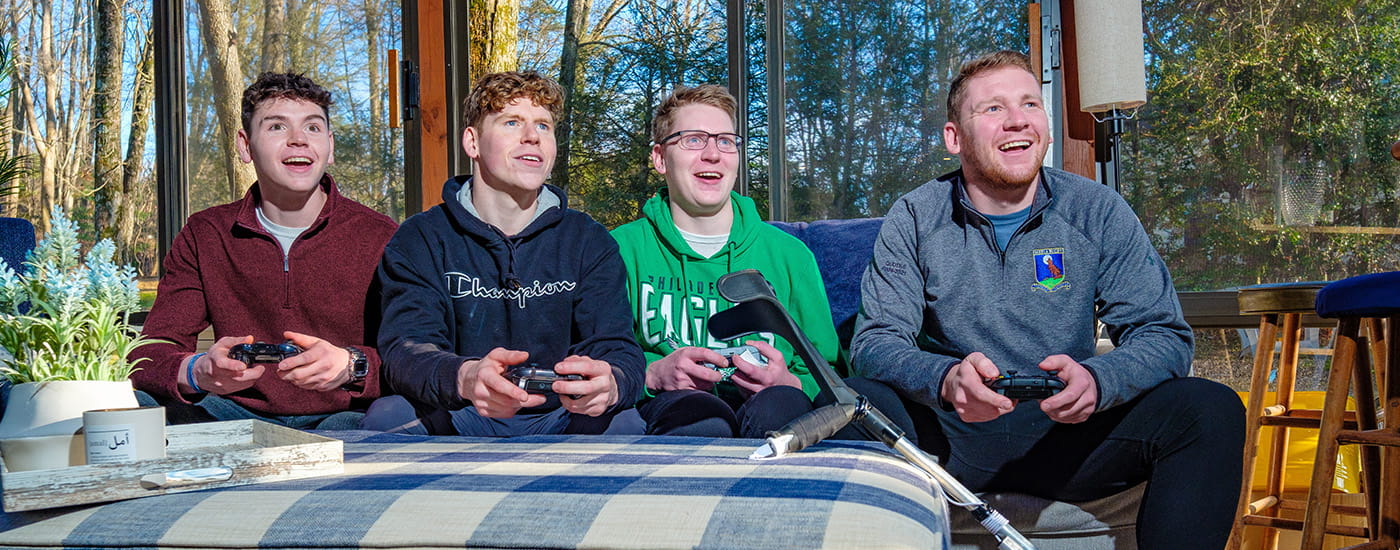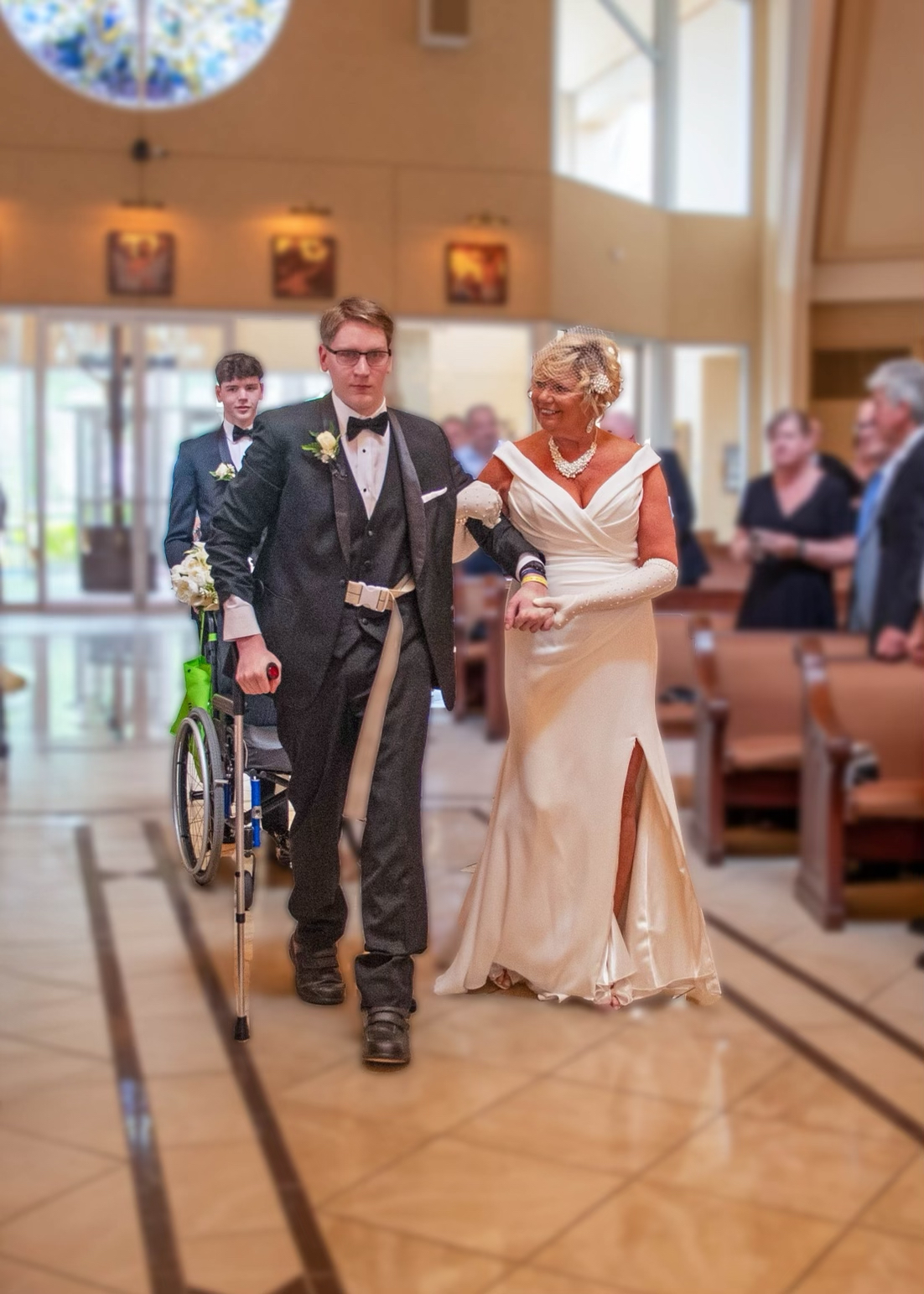An incredible life ahead: Rebounding from a traumatic brain injury

On June 2, 2023, 25-year-old Cole Keith waited in his wheelchair halfway up the aisle of the church on his mother Marie’s wedding day. His brother Kevin began walking Marie up the aisle, but when the pair reached Cole, they stopped. They helped Cole out of his wheelchair, and then — to everyone’s amazement — Cole walked his mother the rest of the way.
"The whole church was crying," recalls Marie, who worked with Cole’s homecare therapist to prepare for the surprise — one of many milestones on his remarkable recovery from a traumatic brain injury so severe that few in his situation even survive.
Just three months earlier, Cole had been involved in a tragic motorcycle accident while swerving to avoid a distracted driver. First responders rushed Cole to Chester County’s only trauma center, Paoli Hospital, part of Main Line Health, where the trauma team jumped into action to assess Cole’s injuries. Despite wearing extensive safety equipment, Cole suffered nine brain bleeds, including one near his brain stem, nine broken bones, and two punctured lungs. He spent three and a half weeks in a Level 3 coma.
"Your son will never be the same," Marie remembers one doctor telling her. Family and friends prayed for a miracle. A few weeks later, Cole opened his eyes. "I knew no matter what physical state Cole ended up in, God had a plan for him. And we were going to make this an incredible life and journey for him," says Marie. For the first stop on that journey, Marie chose Bryn Mawr Rehab Hospital, part of Main Line Health.
Early, intensive, integrated therapy
Cole arrived at Bryn Mawr Rehab Hospital just days after waking up. He couldn’t speak, eat or get out of bed. He couldn’t remember where he was, or even his age. But all that changed after 55 days of intensive inpatient therapy, a minimum of three hours a day, at least five days a week.
Mithra Maneyapanda, MD, medical director of the brain injury program, oversaw Cole’s rehabilitation. Cole received care from physical, occupational, speech, music, art and recreational therapists, as well as an internist, neuropsychologist, case managers and nursing team. Cole’s progress continued with a short stint of homecare followed by outpatient therapy three days a week.
"Every time I’d visit Cole, it would seem like he’d make the next big leap," observes Cole’s older brother, Austin.
"Every single therapist. Every nurse. Every person you encounter is absolutely top-notch." – Marie Keith

Ben Schreiber, PT, DPT, saw Cole’s work ethic firsthand while helping him regain his mobility. "Cole was very motivated and willing to try anything. His mindset really helped," says Schreiber.
When Cole was discharged from inpatient care, he was using a wheelchair and was beginning to walk with a good bit of assistance in his therapy sessions. He was also relearning how to complete activities of daily living like bathing and dressing.
There were lots of hugs from the staff on discharge day. "I felt like I was leaving home because I was so friendly with all of them. They were all my best friends," Cole recalls.
"It was very powerful and emotional for the staff as well as the family," adds Kylie Hartz, MS, OTR/L. "To know the extent of Cole’s injuries and how far he’d come — it demonstrated just what acute inpatient rehabilitation with an interdisciplinary team can do."
Brain injury experts
"The combination of facility, family and faith are what’s making Cole so successful," asserts Marie. "I can’t imagine having him anywhere else during this period of time. Or making any kind of progress like this anywhere else."
"Having a specialized program is key for brain injury patients," notes Dr. Maneyapanda, who is board certified in brain injury medicine. "There’s a lot of unique rehab needs this population has, from specialized physician care to neuropsychological support. Our therapy approaches are also very specialized." In addition to a talented brain injury team, Bryn Mawr Rehab Hospital employs several robotic technologies that particularly benefit this patient group.
"An important part of brain injury recovery involves harnessing the brain’s ability to change, called neuroplasticity. Repetition is key for neuroplasticity, and by using robotic technologies alongside traditional methods, therapists can increase the number of repetitions a patient gets in a session," Dr. Maneyapanda explains.
During his inpatient therapy, Cole benefited from body weight-supported walking devices, the robotic exoskeleton and an upper extremity robotic device. In outpatient, Cole used the new Virtualis Virtual Reality Goggles to work on his weaker side and improve his ability to use his hands together.
"They had me pop [virtual] balloons with my left arm, which is my bad arm. I never experienced anything like that before," Cole describes.
Collaborative care
Involving the patient’s family in care is a high priority for Bryn Mawr Rehab Hospital, and Marie is an equally staunch believer in the importance of family support for a successful recovery. Marie appreciated the opportunity for the family to collaborate with Bryn Mawr Rehab Hospital’s staff, as well as how freely the team communicated with her.
"Dr. Maneyapanda knew I came in at 4 p.m. every day. He would make sure he was available to stop by and give me an update on Cole. Still today, even in outpatient, if I have an issue or I see him in the hall, he’ll stop and talk to me. He’s just absolutely phenomenal," says Marie.
"Every single therapist. Every nurse. Every person you encounter is absolutely top-notch," Marie emphasizes as Cole nods in agreement.
In addition to Marie, Cole’s three brothers, father and stepfather were exceptionally devoted to his recovery. During his inpatient stay, Cole had visitors daily, and there were frequent gatherings of the entire crew. Family members came for training sessions to learn how to best help Cole, and they worked closely with the social worker to prepare the home for Cole’s return. Perhaps most importantly, Cole’s family simply engaged him in life. After his discharge from inpatient, they’d take him to one of their rugby games, downtown for cheesesteaks or to a Phillies game.
"Therapy is hard work. Getting out into the community and translating those skills into things you enjoy is a big motivator," observes Natalie Sibley, PT, DPT, NCS. "Cole’s family makes that happen."
The future
Cole’s next big ambition is walking and caring for his puppy Stella on his own. Fallon Gouveia, MS OTR/L, and Sibley are helping Cole reach that goal by improving his grip strength and balance so he can manage Stella’s leash. "It’s important that each individual we treat feels like a person, not a patient," says Gouveia, noting that the team focuses on ways to adapt activities so patients can engage in them again, even if it looks a little different from before.
As the end of outpatient therapy draws near, Cole’s family has been exploring next steps with help from Bryn Mawr Rehab Hospital’s social workers and support groups. Meanwhile, Cole is eager to tackle the challenges ahead.
As Cole is known to say, "It’s a great day to be alive.
Next steps:
Meet Mithra Maneyapanda, MD
Learn more about inpatient and outpatient rehabilitative therapy
Learn more about the brain injury rehab program
 Content you want, delivered to your inbox
Content you want, delivered to your inbox
Want to get the latest health and wellness articles delivered right to your inbox?
Subscribe to the Well Ahead Newsletter.
